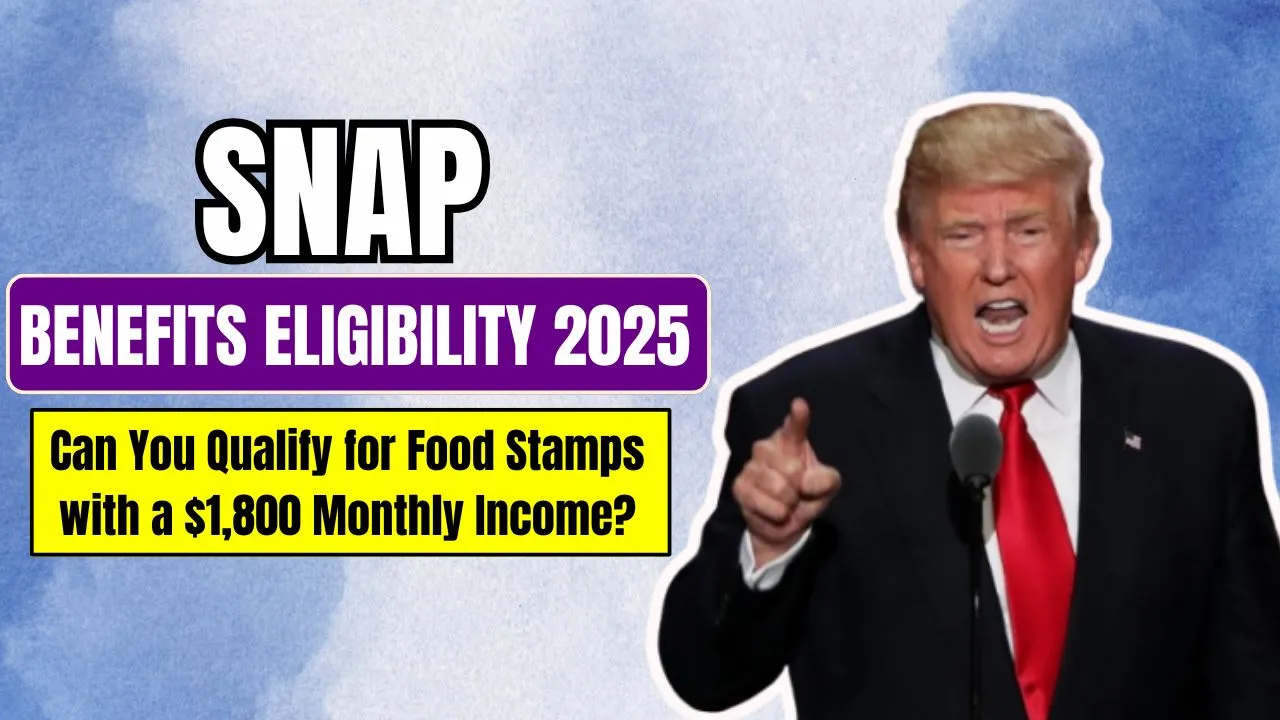SNAP Benefits Eligibility 2025: SNAP Benefits Eligibility 2025: The Supplemental Nutrition Assistance Program (SNAP) is one of the most essential government programs in the United States, offering financial aid to low-income individuals and families so they can afford nutritious food. With inflation and rising living costs, many people are wondering if they qualify for SNAP benefits in 2025.
A common question is: Can you qualify for food stamps with a $1,800 monthly income? The answer is not always straightforward, as eligibility is based on several factors, including gross income, net income, household size, and allowable deductions.
This guide explains SNAP benefits eligibility in 2025, covering income limits, qualifying deductions, and the application process so you can determine whether you are eligible for food assistance.
Understanding SNAP Benefits Eligibility in 2025
To qualify for SNAP benefits in 2025, applicants must meet three main criteria related to income, net income after deductions, and assets.
| Eligibility Requirement | Details |
| Gross Income Limit | Total earnings before taxes and deductions must be at or below 130% of the federal poverty level for household size. |
| Net Income Limit | After allowable deductions, household income must be below the federal poverty level. |
| Asset Limits | Some states consider savings, investments, and property (excluding a primary home) when determining eligibility. |
Even if an applicant’s gross income exceeds the limit, deductions can lower their net income, making them eligible for benefits.
SNAP 2025 Income Limits by Household Size
The U.S. Department of Agriculture (USDA) adjusts SNAP income limits annually based on inflation. The table below outlines the monthly gross income limits for different household sizes in 2025.
| Household Size | Maximum Gross Monthly Income |
| 1 person | $1,630.21 |
| 2 people | $2,198.30 |
| 3 people | $2,766.39 |
| 4 people | $3,334.48 |
| 5 people | $3,902.57 |
For each additional household member, the income limit increases.
A household earning $1,800 per month is above the limit for a single person but below the threshold for a two-person household. Whether they qualify depends on deductions that lower net income.
Allowable Deductions That Help You Qualify
Even if an applicant’s gross income is above the limit, certain expenses can be deducted to reduce net income, potentially making them eligible.
1. Housing Costs
- Rent or mortgage payments
- Property taxes
- Utility bills (electricity, water, heating, gas)
2. Medical Expenses (For Elderly or Disabled Applicants)
- Doctor visits and hospital bills
- Prescription medications
- Medical equipment costs
3. Dependent Care Expenses
- Childcare costs for working parents
- Adult care expenses for disabled or elderly household members
4. Standard Deduction
Every SNAP applicant receives a fixed deduction based on household size, reducing total countable income.
Using these deductions, households with incomes slightly above the gross income limit may still qualify for SNAP benefits.
Example: Can a Household of Three Qualify for SNAP in 2025?
Let’s consider a household of three with a gross monthly income of $2,400.
Step 1: Compare Gross Income to the Limit
- The income limit for a family of three is $2,152 per month.
- Since $2,400 exceeds this limit, they do not automatically qualify.
Step 2: Apply Allowable Deductions
- Rent: $900
- Utilities: $200
- Medical expenses: $150
Total deductions: $900 + $200 + $150 = $1,250
Step 3: Calculate Net Income
- Gross Income: $2,400
- Deductions: $1,250
- Net Income: $2,400 – $1,250 = $1,150
Step 4: Compare Net Income to the Poverty Line
- The poverty line for a household of three is $1,750 per month.
- Since $1,150 is below the poverty line, this household qualifies for SNAP benefits.
This example demonstrates how applying deductions can help higher-income families qualify for food assistance.
Additional SNAP Eligibility Factors
While income and deductions are the primary factors, some states have additional rules that can impact eligibility.
1. State-Specific Adjustments
Certain states:
- Allow higher asset limits
- Offer additional deductions for expenses like childcare subsidies
- Have expanded income thresholds based on cost of living
Checking your state’s specific SNAP eligibility rules is important to determine if you qualify.
2. Asset Considerations
Most states do not count a primary home or car as an asset. However, savings accounts, investments, and additional properties may be included in eligibility calculations.
3. Household Composition
- Elderly or disabled households may qualify with higher income limits.
- Families with children may be eligible for additional food assistance programs.
To verify your eligibility, check the USDA website or text “Food” to 74544 for assistance.
How to Apply for SNAP Benefits in 2025
If you meet the SNAP benefits eligibility 2025 criteria, follow these steps to apply for food assistance.
Step 1: Gather Required Documents
Prepare documents such as:
- Proof of income (pay stubs, tax returns, Social Security statements)
- Proof of expenses (rent, utility bills, medical receipts)
- Identification (driver’s license, Social Security card)
Step 2: Submit an Application
- Apply online through the USDA SNAP website.
- Visit a local SNAP office to apply in person.
Step 3: Complete an Interview
Most applicants must complete a phone or in-person interview to verify eligibility.
Step 4: Receive an EBT Card
Approved applicants receive an Electronic Benefit Transfer (EBT) card, which can be used to buy eligible food items at grocery stores and markets.
Frequently Asked Questions About SNAP Benefits Eligibility 2025
1. What is the SNAP gross income limit for a family of three in 2025?
2. What deductions can help me qualify for SNAP benefits?
Rent, mortgage, and utility costs
Medical expenses (for elderly and disabled applicants)
Childcare and dependent care expenses
3. Does household size affect SNAP eligibility?
4. Where can I check my SNAP eligibility?
Final Thoughts
Determining SNAP benefits eligibility 2025 depends on household size, gross income, allowable deductions, and state-specific factors. Even if an applicant’s gross income appears too high, deductions may lower net income enough to qualify for food assistance.
To ensure you receive the benefits you are entitled to, calculate your total income, apply all eligible deductions, and use official SNAP resources to verify eligibility. Staying informed can help you and your family access essential food assistance in 2025.






